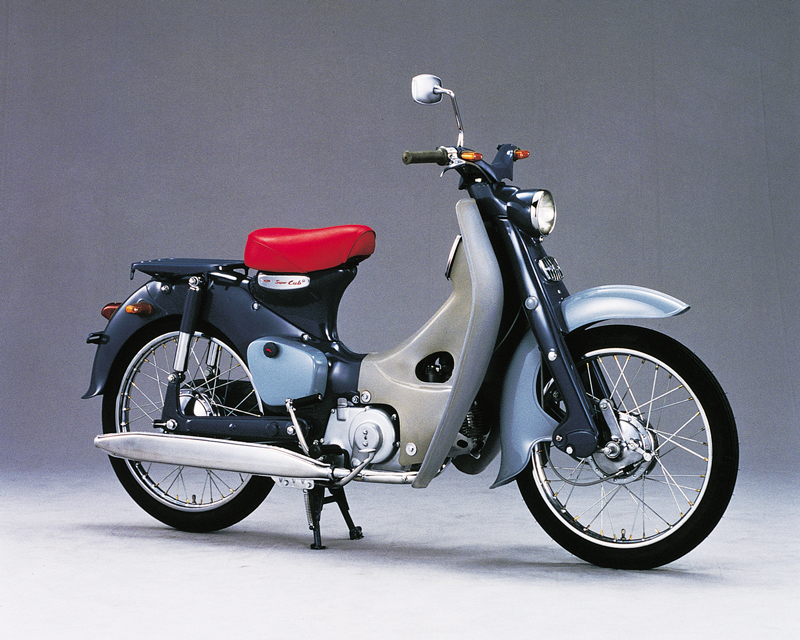
“You meet the nicest people on a Honda.”
The year was 1963 and American Honda, which opened its doors in Los Angeles barely four years prior with eight employees, wanted to change the way car-loving Americans saw motorcycles. When Honda came to the United States in 1959, fewer than 60,000 motorcycles were sold here annually, with most of those being domestic and European models larger than 500cc.
Dealers were skeptical of this bold, upstart new Japanese company, essentially telling 39-year-old General Manager Kihachiro Kawashima, “Good luck, but you’re just splitting a small pie into even smaller pieces.” Undaunted, Kawashima responded: Fine, we’ll make the pie bigger on our own. And the key to that bigger pie was the 50cc CA100, the “nifty, thrifty Honda Fifty,” known in Japan as the Super Cub.
“To succeed in the U.S. is to succeed worldwide. To take up the challenge of the American market may be the most difficult thing to do, but it’s a critical step in expanding the export of our products.” –Takeo Fujisawa, Senior Managing Director and co-founder of Honda Motor Co., Ltd.
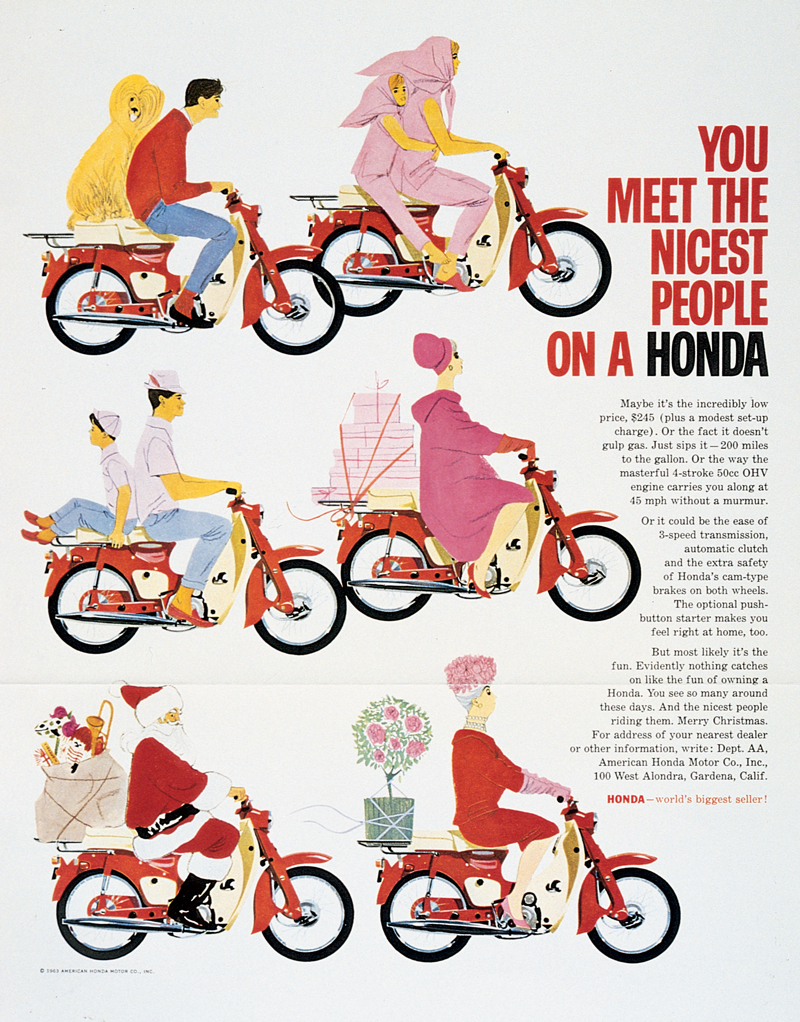
The Super Cub was designed to be accessible: a bike anyone could ride, rugged enough to handle the rough unpaved Japanese roads and with a quiet, fuel-efficient engine. Honda fitted it with its first-ever semi-automatic centrifugal clutch transmission, meaning gear changes were initiated by simply toeing the gearshift lever, no clutch required. The Japanese model was painted a lovely “sea and sky” combination of dark and light blue with a contrasting red single seat, reportedly inspired by Mr. Honda’s penchant for wearing a red shirt and driving a red sports car.
Read our First Ride Review of the 2019 Honda Monkey!
The American version, meanwhile, had two-up seating and a bright, toy-like red and white paint job that reflected American Honda’s strategy of marketing the Super Cub as something fun and unthreatening, the perfect accessory for modern youths of the Jet Age. It was a marked departure from the image most Americans had of motorcycles and “bikers” in general, personified by somewhat dangerous, black leather-clad young men, a la Marlon Brando in “The Wild One.”
And it was a booming success. In 1961 Honda sold 17,000, in 1962 35,000 and in 1963, the year of the “You meet the nicest people” campaign, 90,000 CA100s were sold in the States.
The Super Cub’s new image was “unlike anything that Americans had imagined before. It was that of a completely new vehicle; a motorcycle that simply didn’t seem like one.” –Kihachiro Kawashima, General Manager, American Honda Motor Co., Ltd.
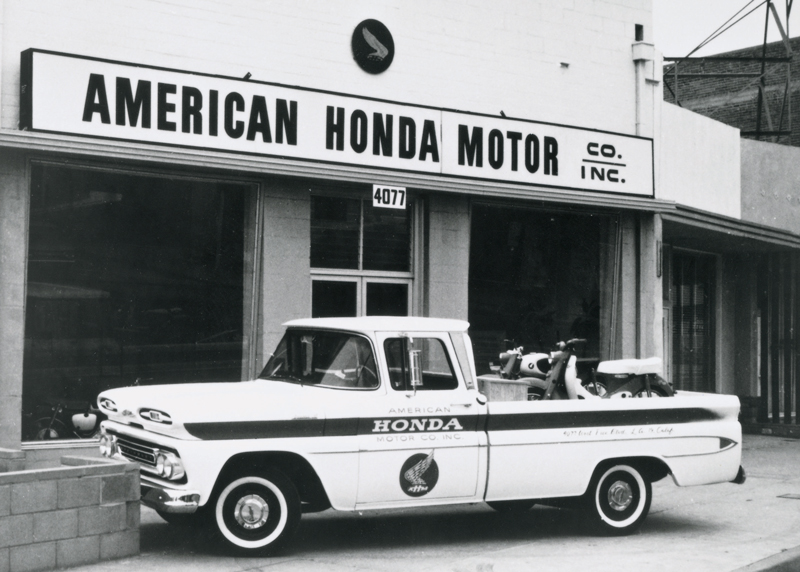
Unfortunately, like most booms the Super Cub ran its course in the U.S., with sales peaking in 1965 and then declining until the model was retired in 1974. It was replaced by the larger displacement C90 and C70 Passport, the last step-through Honda motorcycles sold in the States, which themselves disappeared from our shores after the 1983 model year.
The Super Cub lived on elsewhere, however, especially in Southeast Asia, where reliable, efficient, rugged and inexpensive two-wheeled transportation is a necessity. As of October 2017, more than 100 million Super Cubs had been sold worldwide, the most by far of any motorized vehicle in history. Meanwhile, the unassuming Super Cub had started a revolution, introducing Japanese motorcycles to the American masses and throwing the door wide open for the “Japanese Invasion” that swept the U.S. motorcycle and automotive markets in the late 1960s and beyond.
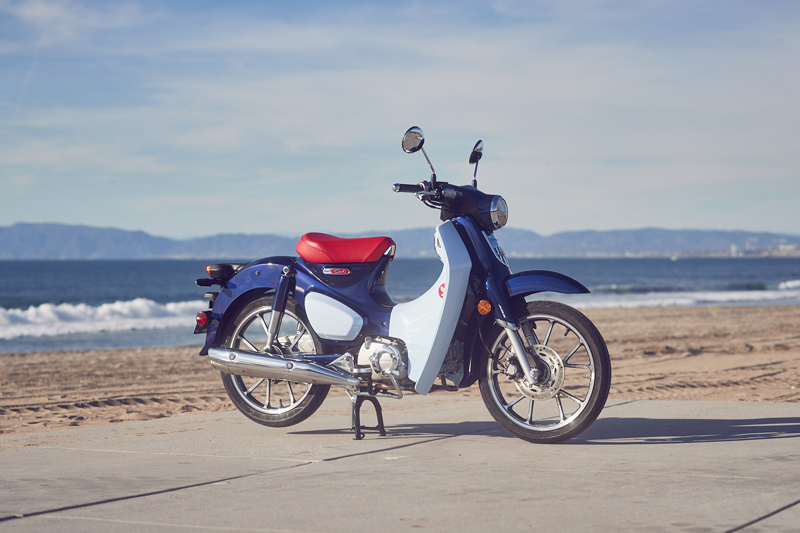
Return of the Super Cub
The year 2019 marks American Honda’s 60th anniversary and also the return of its breakthrough model, now dubbed the Super Cub C125. Based around the air-cooled 125cc single used in the Grom and the Monkey, the 2019 Super Cub is almost as much a time machine as it is a motorcycle.
Fuel injection replaces the carburetor, 17-inch wheels are cast rather than spoked and carry modern tubeless tires, the front disc brake has standard ABS, there’s no kickstarter and the instrument is a combination LCD fuel gauge/odometer/tripmeter/gear indicator with analog speedometer. But the bike still uses that same semi-automatic centrifugal clutch–since utilized in everything from Honda’s mini dirt bikes to ATVs–and it looks almost exactly the way it did 60 years ago, in the classic Japanese “sea and sky” livery.
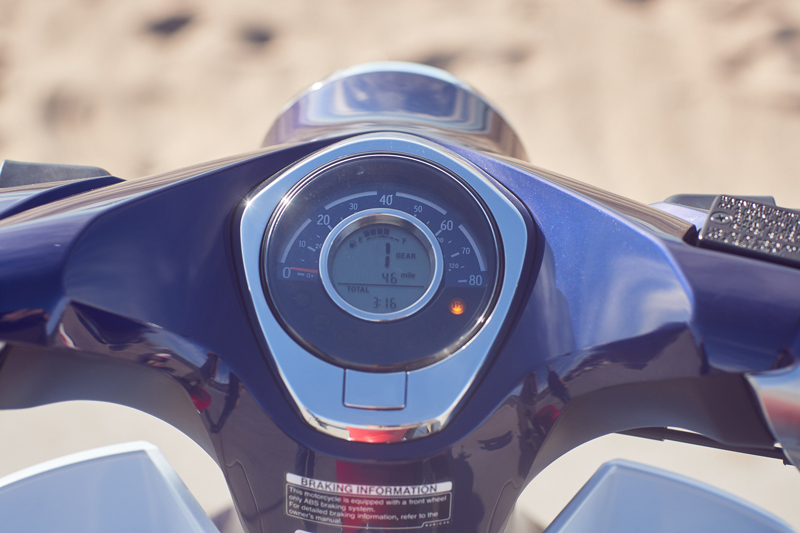
Since every story must start at the beginning, our press launch ride started at the original location of the American Honda Motor Company, a small, nondescript white building on Pico Blvd. west of downtown Los Angeles, where we swung a leg over our time machine–er, motorcycle.
The first clue this is a 2019 model, not a ’62, is the key–or lack thereof. The proximity-sensing fob locks and unlocks the side cover storage (large enough to hold the owner’s manual and not much else) and seat, under which are two helmet lock hooks and the fuel filler, and enables the ignition. Turn the ignition knob to “on,” thumb the starter button and the Super Cub purrs to life.
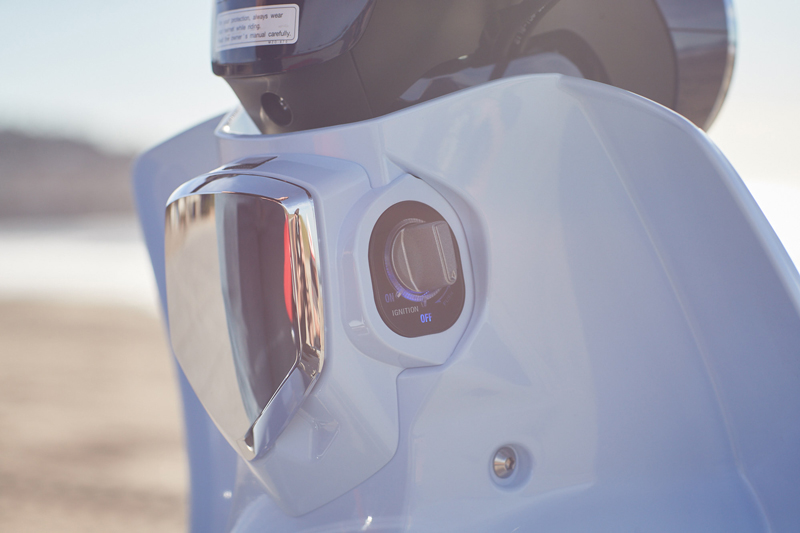
For a rider used to clutching or even Honda’s own automatic DCT transmission, it takes a bit to get used to the lack of a clutch lever while continuing to toe a shifter. Neutral is at the bottom, then it’s all up from there, gears one through four. The lever itself is a heel-and-toe design, and a couple of testers remarked that it was easier to push the heel plate for upshifts, especially with thick boots on.
The transmission uses a centrifugal clutch and a standard spring-loaded clutch plate; when you toe (or heel) the shifter the clutch plate pulls away, the gear changes and the plate returns. The system responds best to an easy-going pace, befitting the Super Cub’s personality. I found that pushing rather than jabbing the lever and operating the throttle just like I would on a traditional bike–rolling it closed slightly during shifts–resulted in the smoothest operation.

Jenny’s Gear
Helmet: Shoei JO
Jacket: Olympia Janis
Jeans: Bolid’ster Jeny’ster
Boots: Rev’It Royale H2O
Like the Grom and Monkey, the Super Cub isn’t designed for speed–55 mph is about the most you’ll comfortably do, and 45 is even better–but the larger 17-inch hoops bestow a stability the other two lack and make it feel more like a “real” motorcycle. Our test ride meandered south and west, including plenty of impatient L.A. traffic, hills, road construction and even a police escort along the sandy boardwalk in Redondo Beach. The Super Cub handled it all with charm and grace, coaxing smiles from scowling, gridlocked drivers like a lion tamer soothing a roaring beast.
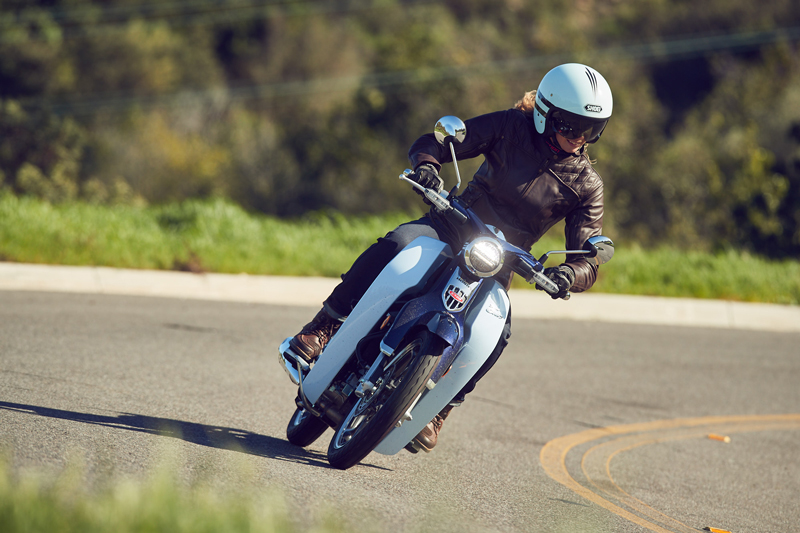
The little single, which probably generates 10 horsepower on a good day, feels smooth and comfortable, thanks at least partially to rubber pads on the rigid-mounted footpegs and the thickly padded red solo saddle. There is no adjustability to either the 26mm inverted front fork or the twin rear shocks, and no passenger accommodations (Honda does offer a nice accessory chrome luggage rack, however). Parking involves dismounting while holding the 240-pound bike upright, then lifting it onto its centerstand (there is no sidestand, nor is there a parking brake).
Check out our Best Bikes for Smaller Riders (and Budgets): 2019 Edition here.
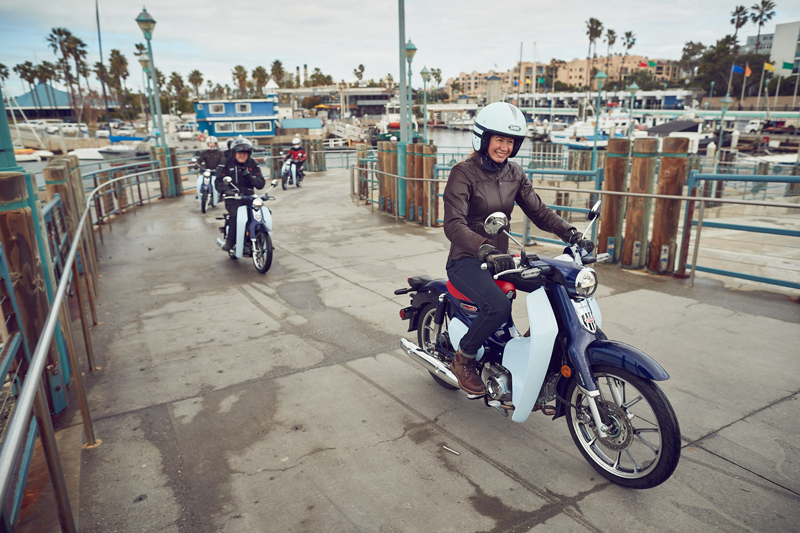
After rolling through the green hills of Palos Verdes, we turned our backs to the sea and cruised to the Honda North America campus. Our time machines had brought us full circle, from 1959’s single, humble storefront with eight employees to the sprawling, 101-acre North American headquarters of the largest motorcycle manufacturer in the world. Honda had one more surprise for us, however.
Blocks away from the main campus, it maintains a private collection of cars and motorcycles, from the first Civic to milestone motorcycles to the latest IndyCar racecars. There they wheeled two bikes out of the museum, a 1961 Japanese-spec C100 Honda 50 and a 1980 C70 Passport, and let us take them for a quick spin. Pull the choke knob and give it a kick–the smooth purr feels immediately familiar. Three gears instead of four, a drum brake up front, but otherwise these were the same fun, easy to ride motorcycles we’d been traveling on all day. The circle closed, the story begins again.
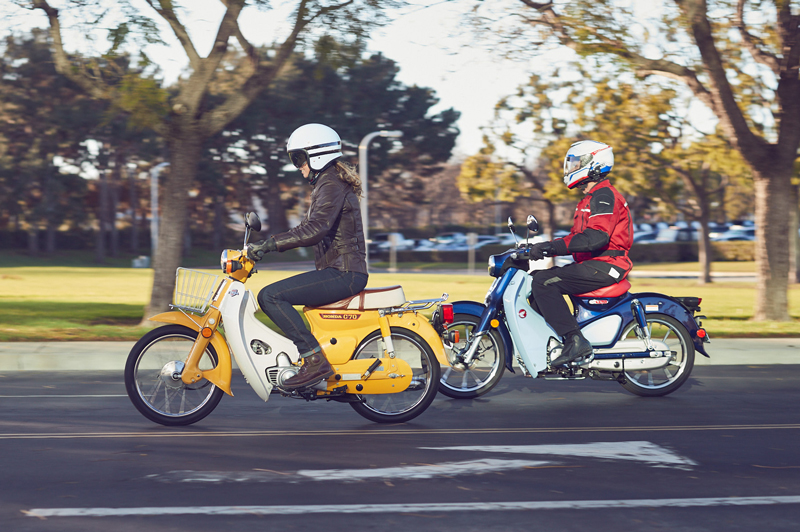
The Super Cub represents everything Honda was and has become, especially in the U.S. where it, aided by some deft marketing moves by American Honda, almost single-handedly altered American motorcycling culture forever. We’re happy to see it again, and maybe it will even inspire a whole new generation of “nice people” to take up two wheels.
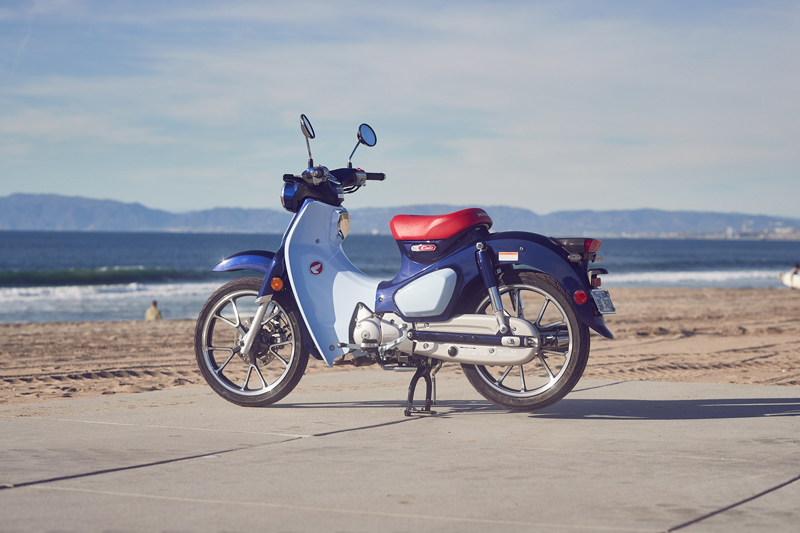
Check out Rider’s Guide to New/Updated Street Motorcycles for 2019
2019 Honda Super Cub C125 ABS Specs
Base Price: $3,599
Website: powersports.honda.com
Engine Type: Air-cooled single, SOHC, 2 valves
Displacement: 125cc
Bore x Stroke: 52.4 x 57.9mm
Transmission: 4-speed, semi-automatic centrifugal clutch
Final Drive: Chain
Wheelbase: 48.9 in.
Rake/Trail: 26.5 degrees/2.8 in.
Seat Height: 30.7 in.
Claimed Wet Weight: 240 lbs.
Fuel Capacity: 1.0 gal.
Avg. MPG: NA
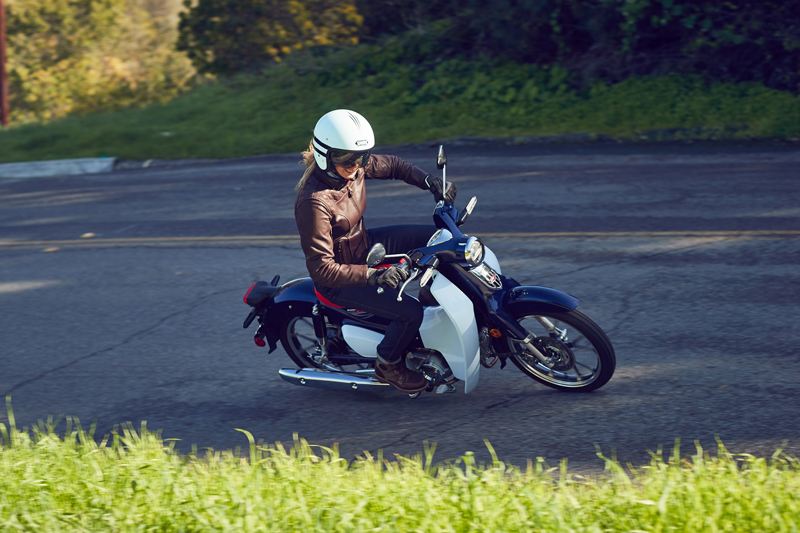
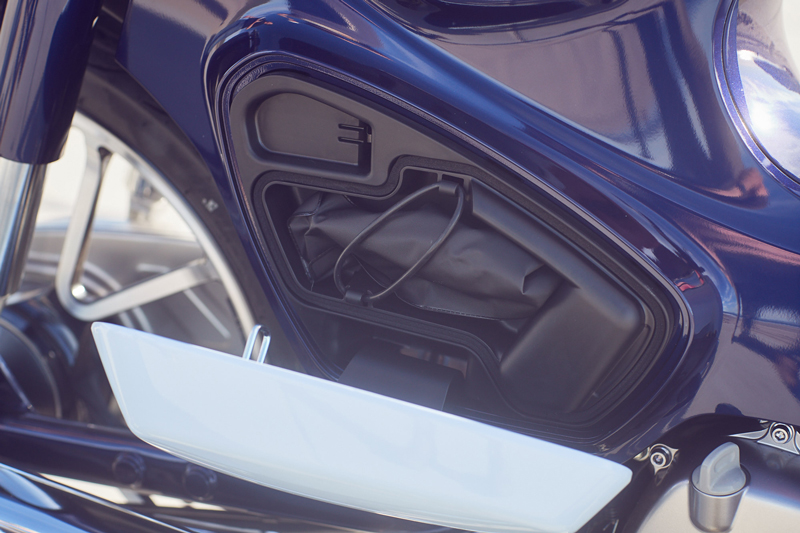
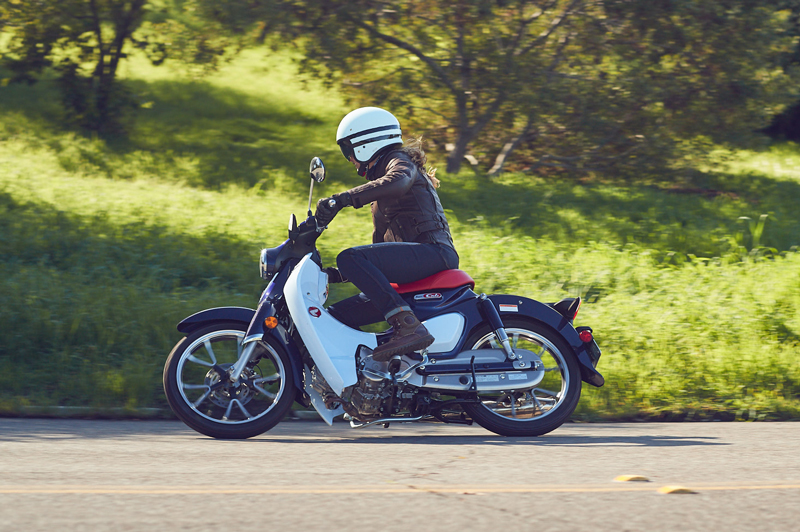
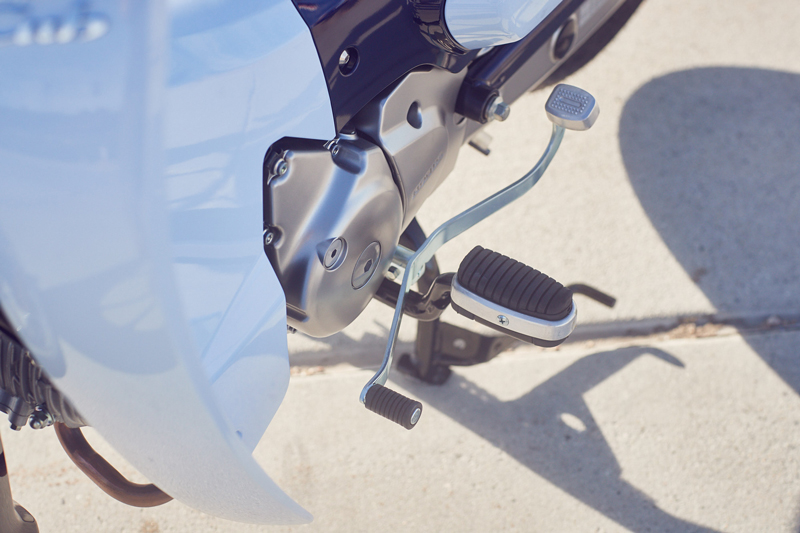








Where is the rear seat and rack!? That is what made the cub super useful and iconic.
You get to purchase it separately.
They are making that money!
There are no passenger foot pegs either.
Scott wrote, “Where is the rear seat and rack?” I agree. The new Super Cub needs a dual seat (for stretch out room if not a passenger), rear foot pegs, a rear rack, and front basket. Make them optional if you must, but make them — because versatile utility and fun riding demand it. I see young people riding two-up on Groms all the time and certainly they’ll expect no less with the new Cub.
As noted in my review, Honda does offer a rear accessory rack, but there are no passenger accommodations or a front basket accessory (wouldn’t be surprised if we saw a basket appear in the catalog, though). We asked the Honda guys about the lack of passenger pegs at the launch (and at the Monkey launch as well), and they offered no explanation other than the U.S. models are solo only. A quick glance at the GVWR tells me that, given a 240-pound wet weight, the Super Cub’s load capacity is a measly 234 lbs. Perhaps that’s the reason? Skinny tires plus larger Americans than 40 years ago equals one-up? I’ll see if Honda can provide some insight, and at least pass along your feedback. -Jenny
>>Super Cub’s load capacity is a measly 234 lbs.>>>
Sounds like legal doubletalk mumbo-jumbo. Or else they have seriously degraded it’s capacity.
According to Honda, the 1966 C90 had a “450lb capacity-in addition to the rider”
Here’s the ad: https://www.pinterest.com/pin/566046246885624417/
I think you’re mistaking the gear change pattern.
It’s neutral on top, four down to 4th, and at standstill, you can push down to neutral.
Downshifts are done with the heel.
No, I was correct. Neutral is at the bottom and you shift up for all four gears. I believe the original CA100 had the neutral at the top shift pattern.
The original had first at the top then neutral then second an finally third. Note neutral was a full shift so to get from first to second took two shifts. Manual says you only need first for hills or two up riding.
Yes, we got to ride a ’61 and an ’83 Passport, and I noticed the different pattern on the ’61. It was fun to ride them back-to-back, really illustrated how similar they all felt.
Listen to the Beach Boys “Little Honda”, they only go through three gears……all the Cub had.
The reason for no rear footpegs is the same for both bikes.
Footpegs must be attached to frame…not swingarm.
NO bikes are imported into the US or UK nor most Western countries with swingarm mounted footpegs.
back in the dark ages, a friend had a Yamaha (right hand shift i think) with a rotary shift pattern that went from fourth to first as you continued to shift after fourth in the same direction, often resulting in first gear slides at 60 mph. Entertaining, to say the least. I think it was 250 preceding the hugely successful two-stroke RD twins. I know, not Super Cub stuff, but interesting anyway.
The uk shift pattern is Neutral then down to 1-2-3-4 if you are stationery in 4th gear you can press down again to get neutral and 1st. How do I know this? I have one! The Americans I believe favour the toe up like conventional bikes hence the toe shifter and not two pedals like the uk. The two pedals is as designed so you don’t scuff your shoe toes but the Americans don’t like itI guess I get 172mpg (UK GALLONS) from mine with 500 miles on the clock. You can get really smooth down shifts into lower gears by starting the pedal press this disengages the clutch blipping the throttle as on a normal motorbike and the gear slips in smooth with no jerkiness. Also can I dispel the rumour that the rack has to be bent to fit. What I recommend is some anti scuffing yacht tape on the back of the mounts trim so it is the same profile. The tape prevents the steel scratching the paint and slowly feed it into location. Bolt it down leaving the clear film yachting tape on the back of the lugs I tightened the shock mount at the top to 20Nm. Easy! Ignore that guy who bends the thing all over the shop! Do you think a mass production outfit like Honda cannot accurately form some sheet metal, its ludicrous!
Here in Thailand it’s not uncommon to see 3 people on one of these……about the same weight as one yank. Awesome bike, tough as nails, indestructible engine.
If they reintroduce the “CT” trail version in the U.S., I’d be the first to buy one.
Good write up, Ms Smith! Does it go thru puddles w/o dying?
My cousin’s father bought him one of these in 64 or 65 and this was the first motorcycle I rode by myself. I’ve been riding ever since and still own Honda’s, a ‘94 Magna and 2014 CTX1300. I just love the V-4s
My brother in law had a Trail 90 that he let me ride around the neighborhood in the Pasadena, CA area. What a hoot for a kid to get back in the day. That fun plus riding home from Jr. High School on an older neighbor’s Mustang got me hooked. My last bike was the epitome of sport touring which I rode up and down California as well as mountain riding near Pasadena. Yes, I loved my 1989 Yamaha FJ 1200!
I’m restoring Honda’s “Big” motorcycle, a 1967 CB305 Super Hawk
I’d like to see the selling price on these new cubs UNDER 3000 I think they’d generate a lot more interest?
I have one in my barn ….and an extra engine! Next to my Super-90 S90 and a Trail 90…
I had a cub back in High School in 1965. I loved it but sold it for a S 90 the next year. Fast forward to 1986, I saw a C 70 for sale on our Maine street and told my wife I would love to have one like it again. She surprised me on Fathers Day that year bu buying it for me. I rode it for 28 years. I even had my mechanic bore it out to 90 cc (just like the 90cc version back in the late 60s) and he managed to put in a 4 speed tranny. Had to replace the front spings once, was stolen once and returned and attempted theft a second time. I put more than 18K miles on it. Sold it in 2012 and bought a Yamaha Zuma 125 in 2013. Now I want this new Cub.
Tourmeister Thom
WOW!! Did THIS bring back a ton of fun memories…being 69 yrs old, I thought it was a 55cc bike. I DO remember it was an automatic. The iconic knee guards…as a kid this was the bomb!! It was also the very 1st MC I ever rode and have never forget over the years~~because I never stop riding!!! Thanks for this article.
Looks like it could be fun, but do agree on the two up response. I have been riding sense I was 14 and now am 76 and still riding with my Triumph Speedmaster and Honda Goldwing trike. I have had many Honda’s through the years and still love them.
“Everything old is new again”…small Hondas like this and the Minitrail are what got most people, myself included into motorcycling!
Great memories of my first Honda Fifty came flooding back. Great review. At 70 years old I am planning to downsize from my last Honda 1100. Probably won’t go this small . But I do agree it would be better if it was under 3. Considering my first Honda 50 was under 3…. Hundred that is. Great write up.
Good luck finding “the nicest people” in a land of Trump voters. This bike is a good choice in these days of increasing greed of the rich and poverty for everybody else. The price could be better, though.
Maybe some rich dude will give you one.
After all…you deserve it, right?
Takes a real ass to drag politics into a motorcycle review. Good job. How can this country possibly survive without your witty and pertinent information?
In the June 2018 release it states the 2019 Super Cub C125abs would come with a side stand, center stand and rear rack.
Why are they not on the USA model you reviewed? I put a deposit on one last June, to make sure I would get one and am concerned it is not going to be what was previously reviewed as the 60th anniversary model.
The release actually says nothing about a side stand, center stand and rear rack. It is true those are shown in the photo, but you’ll notice that photo is also clearly labeled “non-U.S. model.” This is a common practice as manufacturers release early info on a motorcycle, often shown initially at EICMA, Tokyo, INTERMOT or some other international venue, before final details on a U.S.-spec model have been finalized. As we now know, the U.S. model will have a center stand but no side stand. A rear rack is an optional accessory (it is chrome, not blue as shown in the initial press release photo). Hopefully this doesn’t deter you from this fun little bike.
Will not go down well in Thailand without a seat that accepts passengers. I have had many cubs over the years from a 50CC when I was 16 (now 65) then a 90CC, 100 CC, 125cc x 3, and last one was 110 CC. However, I would not buy a single seater. I guess I’ll have to think about a Suzuki or Yamaha equivalent.
I just had to echo the comments above on the lack of passenger accomodation. I’ve had a Cub 50 which I bought in 1995 and it still runs, a 2013 Innova which had a nice seat and pegs for a second passenger plus a kickstand. If my son hadn’t totalled the Innova and the lousy Luxembourgish dealer here telling me that it was not fixable it would be around for a lot longer with me. As it was I gave it to a mechanically inclined friend in Greece who managed to fix it and he will be enjoying it for many years to come. I was really waiting for the new cub to be like the Innova or
wave as is known in other parts of the world, so that I could buy it. If they decide to change their minds and make it more like the Innova i.e. passenger accomodation and kickstart plus side stand I will buy it for sure.
Easy to figure why only a single seat. Sales , Honda wants one American butt per bike/seat so everyone can enjoy the fun and sell two bikes instead of one ! Price is too high , that will hurt sales , $2999 and then they would sell like hot cakes .
Honda, please list a bunch of accessories for this machine!! I will buy all of them. I need baskets, seat option, sidestand, and windscreen.
I will sell my 125 Zuma 1 second after this is available.
Btw, I’m keeping my C70, Passport.
Steve
Zuma was the best of the small bikes until the Grom smacked it down.
I bought the first Supercub in phoenix a few months back, have over 400 miles on it, love it but wish I had a rear seat and begs for my wife. She won’t ride one herself, sexy bike! Runs great! Phil
Tons of footpegs and every other mod here:
https://www.facebook.com/groups/414402119041567/
And here:
https://www.facebook.com/search/top/?q=honda%20super%20cubs%20usa&epa=SEARCH_BOX
Any pointers on downshifting? Got the upshifts smoothed out. But the downshifting, especially 3rd to 2nd and 2nd to 1st are almost stoppie worthy. So miss a clutch or a true DCT.
I had trouble perfecting a smooth 2nd to 1st downshift too. Best I can tell you is, do it as close as possible to actually being stopped, and try to push the lever rather than jab at it as you “blip” the throttle.
Thanks for the tip. I was coming to that conclusion, too, on the 2nd to 1st downshift, especially. Glad to know I’m not the only one struggling with shifting it. Felt like a rank beginner. 🙂
I already have two Monkeys (one for each foot) and they are flawless small motorcycles and they sit beside two 160 hp Ducatis. But i ride the Monkeys the most and all that i can find wrong with them is the name! I have come to expect first class from Honda all the way down to the Super Cub I just bought. I may wear a Nixon mask when I ride it home so no one will know me. I have been riding since 1961 (72 years old and been to Barber Motorsports Museum – do images on it – 50 times). The small motorcyle reissues by Honda are a real treat. My Monkeys draw a crowd everywhere and I know the little Cub will too. Thanks Honda, now bring me a racing 50 for the street to ride to the Suches, Georgia annual 50cc challenge, if it is still on.
I’ve got a cub 125 I’ve had it from new I’ve run it in I’ve now got a bad vibration on engine it’s not a smooth ride any suggestion please
Beautiful bike..
Mine is a 2020.
Very well made.
Red is the fastest color.